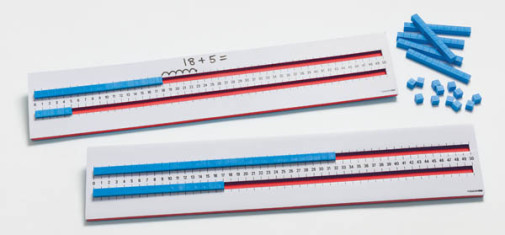We use cookies to make your experience better. To comply with the new e-Privacy directive, we need to ask for your consent to set the cookies. Learn more.
Base Ten Dual Number Line
We already know number lines are useful for showing sequence and teaching skip counting, but now you can add your base ten cubes and do even more. This one is made of dense red foam, has a white surface that can be used with dry erase markers, shows numbers 1-50 and has 2 channels running the length of the number line. Your base tens slide right into the channels. Includes an 8 pg activity guide. Use to demonstrate addition, subtraction, multiplication and division. Measures 20.5 x 4 x 5 ~ Sara
This versatile tool, designed to be used with standard 1-centimeter base ten blocks (units and rods of 10), helps students visualize and solve operations, ratio, and percent problems.
The durable 1 cm foam number line is 4" high by 21" long and has dual channels that can hold up to 50 base ten units each and a dry-erase writing surface.
The dual channels provide students the ability to represent and model equations and problems in a structured, meaningful way.
Includes teaching notes with sample activities for CCSS.
Does not include base ten blocks or rods.
| Product Format: | Other |
|---|---|
| Brand: | Didax |
| Grades: | K-4 |
| EAN/UPC: | 706406116320 |
| Length in Inches: | 23.625 |
| Width in Inches: | 5 |
| Height in Inches: | 0.375 |
| Weight in Pounds: | 0.2 |

